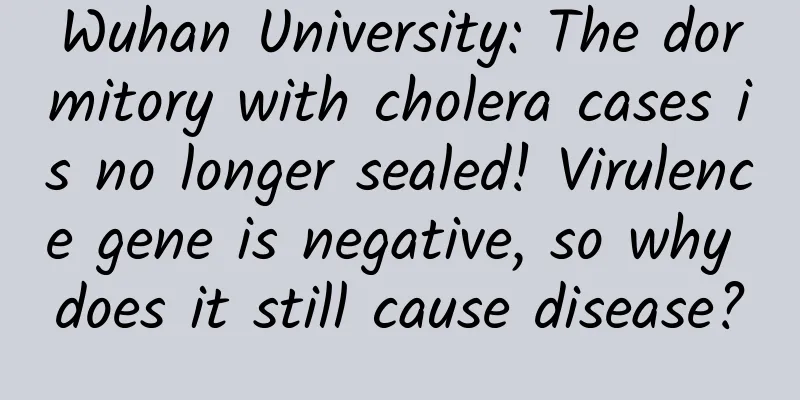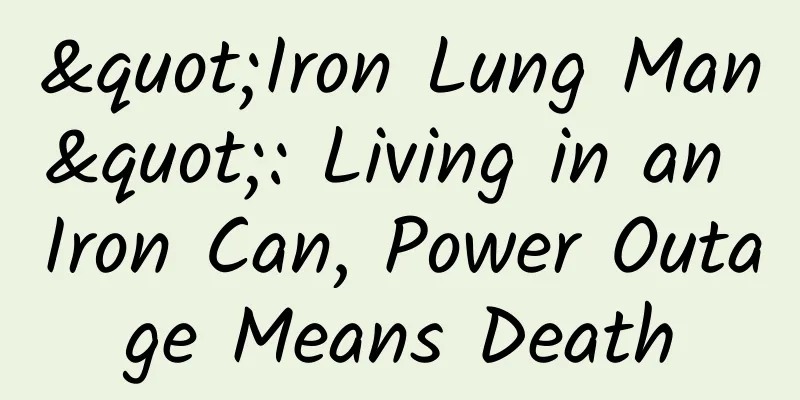Wuhan University: The dormitory with cholera cases is no longer sealed! Virulence gene is negative, so why does it still cause disease?

|
According to the official Weibo of Wuhan University, at 21:30 on the evening of July 12, the lockdown management of Dormitory 8 of the School of Engineering of Wuhan University, where a case of cholera had previously occurred, was lifted. Cholera is an acute diarrheal infectious disease caused by food or water contaminated with Vibrio cholerae, with the peak incidence in summer. Earlier, the Health and Health Bureau of Wuchang District, Wuhan City, Hubei Province, reported on the 11th that a student of Wuhan University was diagnosed with cholera. The professional identification of the disease control department pointed out that the serological agglutination test of the case was positive for O139, diagnosed as cholera, and negative for virulence genes. A netizen left a message asking: What does virulence gene negative mean? From the literal meaning, the disease control department conducted a genetic test on the strain that causes cholera, and the result was "negative", which means that this strain does not have virulence genes, so why can it still cause diarrhea in patients? What does it mean that the serological agglutination test is positive for O139? The Science and Technology Daily reporter contacted Guo Wei, deputy director of the Department of Infectious Diseases at Tongji Hospital of Huazhong University of Science and Technology, to answer questions and clear up confusion. What are virulence genes? The naming of a gene is basically related to the function of the protein it encodes. The "virulence" in the virulence gene reported by the health department this time refers to the cholera toxin of Vibrio cholerae. The virulence gene is the gene that encodes the cholera toxin. "Cholera toxin is the main pathogenic factor of Vibrio cholerae, and it is the most toxic toxin known to cause diarrhea." Guo Wei told Science and Technology Daily that if the infected strain has this virulence gene, the bacteria will secrete cholera toxin to attack the patient's intestinal mucosal cells. The cells will continue to secrete fluid, and the gastrointestinal tract will discharge a large amount of fluid like "opening a floodgate." If the infected person does not get water in time, the body will become severely dehydrated. As you can imagine, patients infected with Vibrio cholerae carrying virulence genes will have very severe clinical symptoms. "A large number of cells will dehydrate and die, which will lead to some serious complications, including renal failure, hyperkalemia, arrhythmia, etc. If not treated in time, it will endanger life," said Guo Wei. Does negative mean “non-toxic”? So, does the absence of virulence genes in Vibrio cholerae mean that it is non-toxic? Not really. "Vibrio cholerae also secretes other substances that are harmful to the human body, such as endotoxins, hemolysins, hemagglutinins, etc." Guo Wei said that the role of endotoxins in causing disease should be taken seriously, and there have been reports of infants and young children developing sepsis and meningitis after infection. "However, most patients can recover without the use of antibiotics if they are given timely rehydration." Guo Wei stressed that although cholera is a bacterial infectious disease, the key to treating cholera is rehydration. If rehydration is not done well, it can be fatal. Antibiotic treatment can only shorten the course of treatment and reduce the number of diarrhea episodes. It is an auxiliary treatment for fluid therapy. Therefore, the abuse of antibiotics is not recommended. Virulence genes have epidemiological significance. A negative result means low transmissibility and low possibility of epidemic. If a positive result is detected, it means that there is a possibility of a pandemic, and prevention and control measures need to be more stringent. Why are virulence genes related to transmissibility? A review article published in the Proceedings of the National Academy of Sciences in 2003 showed that Vibrio cholerae is grouped according to its O antigen, and there are currently at least 206 known Vibrio cholerae serogroups (which can be imagined as different Vibrio families). Before O139 appeared, O1 was the only "family" that had ever caused a pandemic. Moreover, the initiation of a pandemic and the positive test for virulence genes always occurred at the same time. In 1992, a cholera epidemic occurred in Bangladesh that infected more than 100,000 patients, of which 124 strains were isolated that were not O1. "Vibrio cholerae has flagella, which are like small engines. Under dark-field microscopy, it will run continuously and has extremely strong motility. However, as long as agglutinating serum against that serogroup is added, the 'motor' will be locked and unable to move." Guo Wei said that different serogroups correspond to different antisera, so they can be used to preliminarily distinguish which "family" Vibrio cholerae belongs to. People found that the strain that caused the epidemic in Bangladesh could still run after adding the agglutinating serum corresponding to O1. A new strain that caused the epidemic but was not O1 was discovered. The aforementioned paper commented: The concept that non-O1 serogroups would not cause large-scale diarrheal outbreaks has been broken. Although the new O139 has emerged, it still follows the rule that it will only become widespread if it possesses virulence genes. "It is also easy to understand logically. Virulence gene-positive bacteria can secrete cholera enterotoxin, which can cause severe diarrhea. The more excrement is discharged, the easier it is to pollute the environment and water sources, which can lead to more subsequent infections." Guo Wei said that this is very similar to the "seeding" ability of plants. If they have the ability to spread, they will cause a pandemic, and if they have poor spreading ability, they will only cause very few infections. Therefore, the presence or absence of virulence genes is one of the keys to determining whether cholera can become a pandemic. One picture shows you how to prevent cholera correctly? Comprehensive sources: Wuhan University official Weibo, Xinhuanet, Science and Technology Daily, etc. |
<<: Can computers think like babies? New research gives AI the same intuitive perception as humans
>>: It's here again! Why are there so many supermoons? What are the highlights?
Recommend
Are there bacteria that "eat paper" in nature?
When I saw a netizen asking "Are there bacte...
As the Year of the Ox approaches, are those enduring health-preserving methods in life secrets or misunderstandings?
Niu Niu: The New Year is prosperous, let’s make s...
Why does my girlfriend always think she is right? (Must read for boys)
One minute with the doctor, the postures are cons...
What are the parts of crayfish that you cannot eat? The shrimp thread, the shrimp roe, or...
In summer, crayfish becomes the "king of mid...
Tips for developing a big Tik Tok account that attracts a lot of fans!
So what kind of influencers have more long-term a...
This new project is harvesting primary school students, one card can be sold for 210,000! Be careful
Since its inception, card-drawing mobile games ha...
Is your body exhausted? A table to calculate your fatigue index
Do you have the following symptoms? Your head fee...
The core strategy for high click-through rate in live broadcast rooms!
Why do we need to conduct research on high clicks...
It can "breathe fire"! Be careful when buying it
Can you buy a hair dryer for 15 yuan? Is it safe?...
Who will win the battle of words? ——Front-end and back-end passionate debate
Are you still worried about having nowhere to dis...
How to write a company celebration event planning proposal? Six aspects need to be grasped
2019 is coming to an end and 2020 is about to arr...
Antarctica is turning green, but that could be bad news
At present, in the northern hemisphere where my c...
up to date! Data rankings of 60 information flow advertising platforms!
Today I bring you the latest traffic rankings of ...
99% of blind box marketing is ineffective?
During the May Day holiday, major brands have bee...
5 steps + 7 tips to teach you how to create high-conversion information flow copy!
In the past two years, information flow advertisi...









